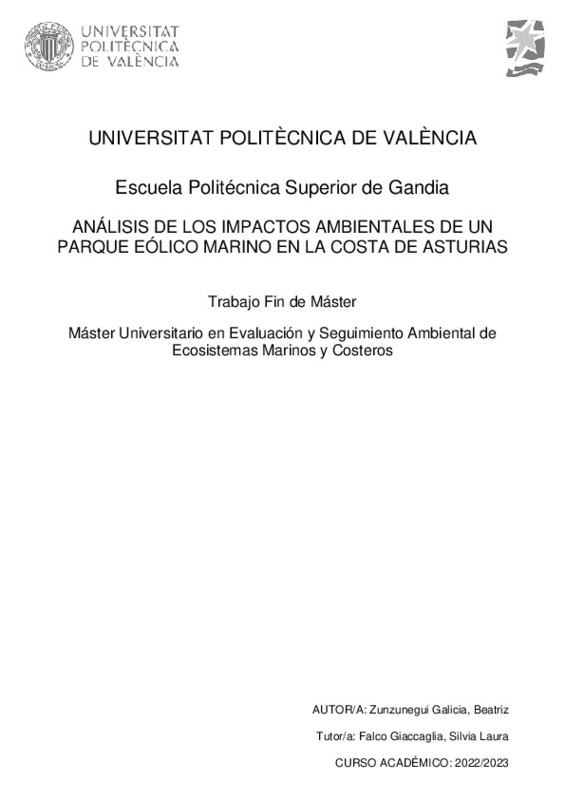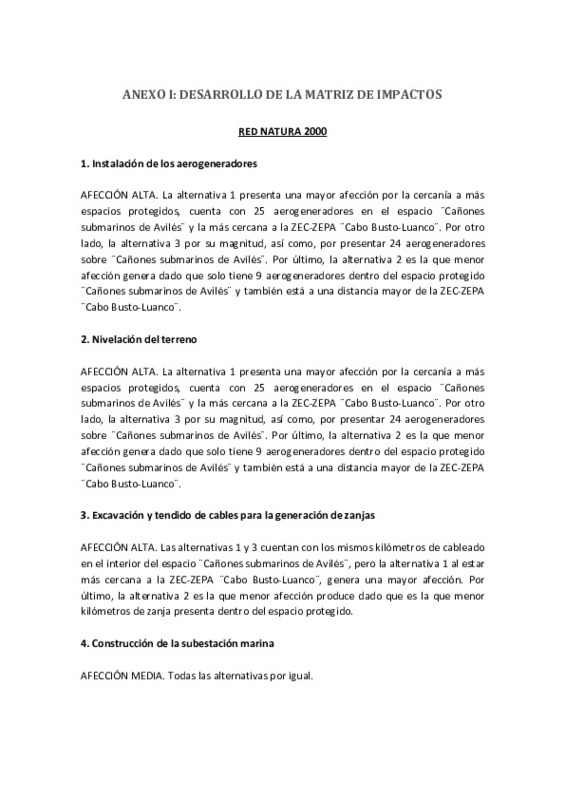|
Resumen:
|
[ES] En los últimos años, se ha presenciado una transición en el ámbito energético, definido por
un cambio hacia fuentes de energía renovables. Entre las diversas formas de obtención de energías
alternativas, los parques ...[+]
[ES] En los últimos años, se ha presenciado una transición en el ámbito energético, definido por
un cambio hacia fuentes de energía renovables. Entre las diversas formas de obtención de energías
alternativas, los parques eólicos marinos presentan numerosas ventajas: la velocidad del viento es
mayor y más constante, pero también implica costes de inversión y de mantenimiento más altos. Por
otro lado, hay una clara inclinación hacia los parques eólicos marinos debido a su mayor rentabilidad
económica y su menor impacto medioambiental. Por ello, en este trabajo llevó a cabo el análisis de
los impactos ambientales del proyecto de un parque eólico offshore en la costa de Asturias, basado
en la metodología clásica de un Estudio de Impacto Ambiental (EsIA).
Así pues, se han estudiado las tres alternativas propuestas, realizando una comparativa con el
fin de seleccionar aquella más óptima, en cuanto a ubicación y batimetría, así como la opción que
menores impactos ambientales generase, teniendo en cuenta aspectos como la afección a los espacios
Red Natura 2000 y el sector pesquero, entre otros.
Tras la valoración y desarrollo de los impactos generados por las distintas alternativas, se
consideró que la alternativa que desde el punto de vista funcional (mayor producción energética),
ambiental (mayor disminución de las emisiones de gases de efecto invernadero y menor afección a
los espacios protegidos) y social (creación de empleo y desarrollo de la economía de la zona) es la
alternativa situada a 24 km de distancia aproximadamente frente a la costa de Gijón, formada por 42
aerogeneradores tripala flotantes con potencia unitaria 5 de MW, generando una potencia nominal
de 210 MW
[-]
[EN] Recent years have seen a transition in the energy arena, defined by a shift towards renewable
energy sources. Among the various ways of obtaining alternative energy, offshore wind farms have
numerous advantages: the ...[+]
[EN] Recent years have seen a transition in the energy arena, defined by a shift towards renewable
energy sources. Among the various ways of obtaining alternative energy, offshore wind farms have
numerous advantages: the wind speed is higher and more constant, but it also implies higher
investment and maintenance costs. On the other hand, there is a clear inclination towards offshore
wind farms due to their higher economic profitability and lower environmental impact. For this reason,
in this work he carried out the analysis of the environmental impacts of an offshore wind farm project
on the coast of Asturias, based on the classic methodology of an Environmental Impact Study (EsIA).
Thus, the three proposed alternatives have been studied, making a comparison in order to
select the most optimal one, in terms of location and bathymetry, as well as the option that generates
fewer environmental impacts, considering aspects such as the impact on spaces Red Natura 2000 and
the fishing sector, among others.
After the assessment and development of the impacts generated by the different alternatives,
it was considered that the alternative that from the functional point of view (greater energy
production), environmental (greater reduction in greenhouse gas emissions and less impact on
protected areas) and social (creation of employment and development of the economy of the area) is
the alternative located approximately 24 km away off the coast of Gijón, it is made up of 42 threeblade floating wind turbines with a unit power of 5 MW, generating a nominal power of 210 MW
[-]
|








